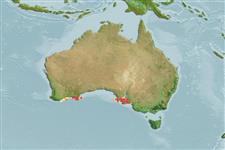Environment: milieu / climate zone / depth range / distribution range
Ecologie
marien rifbewoner; diepte 0 - 10 m (Ref. 57886). Temperate; 34°S - 36°S (Ref. 57886)
Eastern Indian Ocean: Australia.
Grootte / Gewicht / Leeftijd
Maturity: Lm ? range ? - ? cm
Max length : 11.5 cm TL mannelijk / geslacht onbekend; (Ref. 33839); 10.3 cm SL (female)
Korte beschrijving
Morfologie | Morfometrie
Dorsale zachte stralen (totaal): 97-112; Anale zachte stralen: 57 - 64; Wervels: 52 - 57. The species is distinguished by having a very elongate body; vertebrae 19-22 + 33-36 = 52-57,
dorsal fin rays 97-112, anal fin rays 57-64, D/A 42-51, V/A 23-26; body with scales; supraorbital pore behind eye present; lower preopercular pores 3, the 2 first tubular; posterior infraorbital pores 3; broad angle on ventral maxilla positioned behind rear of eye; exposed opercular
spine bent upwards; lower lip with skin folds; single pair of pseudoclaspers curved, hockey stick-like, thin; penis slightly shorter than pseudoclaspers, with hook at tip; otoliths rounded anteriorly and expanded posteriorly, without postdorsal angle, otolith length to height ratio
2.3-2.4, sulcus wide (Ref. 57886).
A locally abundant, secretive species inhabiting inshore reefs (Ref. 34024). A female specimen ( 77 mm TL) was reported by McCulloch and Waite (1918) to contain three fully developed embryos, 28 mm in total length. Coloration is reported to include dark pigmentation dorsally. Specimens are also commonly found with copepod remains in the stomach (seen from x-rays). Maximum length for female is 103 mm SL (Ref. 57886).
Levenscyclus en paargedrag
Maturiteit | Voortplanting | Paaien | Eieren | Fecunditeit | Larven
Møller, P.R. and W. Schwarzhans, 2006. Review of the Dinematichthyini (Teleostei, Bythitidae) of the Indo-west Pacific, Part II. Dermatopsis, Dermatopsoides and Dipulus with description of six new species. The Beagle 22:39-76. (Ref. 57886)
Status op de Rode Lijst van het IUCN (Ref. 130435)
Gevaar voor de mens
Harmless
Gebruik door de mens
Visserij: van geen belang
Meer informatie
Lokale namenSynoniemenMetabolismePredatorenEcotoxicologieVoortplantingMaturiteitPaaienPaaiaggregatiesFecunditeitEierenOntwikkeling van de eieren
Leeftijd/GrootteGroeiLengte-gewichtLengte-lengteLengtefrequentiesMorfometrieMorfologieLarvenLarvale populatiedynamiekRekruteringAbundantieBRUVS
ReferentiesAquacultuurAquacultuurprofielKweeklijnenGeneticaElectrophoresesErfelijkheidZiektesVerwerkingNutrientsMassaconversie
Tools
Speciale rapporten
Download XML
Internetbronnen
Estimates based on models
Preferred temperature (Ref.
123201): 16.8 - 18.3, mean 17.2 °C (based on 51 cells).
Fylogenetische diversiteitsindex (Ref.
82804): PD
50 = 0.5312 [Uniqueness, from 0.5 = low to 2.0 = high].
Bayesian length-weight: a=0.00389 (0.00180 - 0.00842), b=3.12 (2.94 - 3.30), in cm total length, based on all LWR estimates for this body shape (Ref.
93245).
Trofisch niveau (Ref.
69278): 3.4 ±0.5 se; based on size and trophs of closest relatives
Weerstandsvermogen (Ref.
120179): laag, minimale populatieverdubbelingstijd 4,5-14 jaar (Assuming Fec < 100).
Fishing Vulnerability (Ref.
59153): Low vulnerability (10 of 100).
